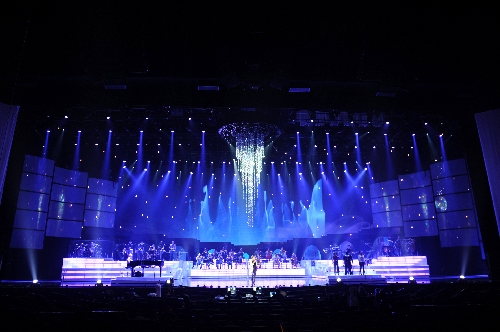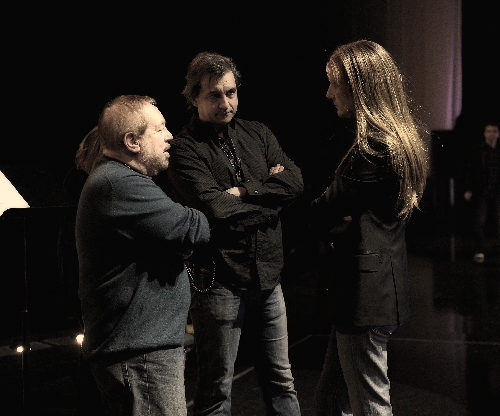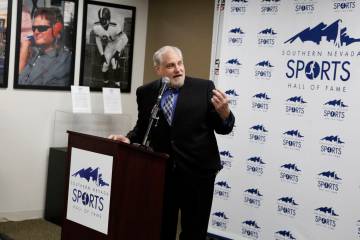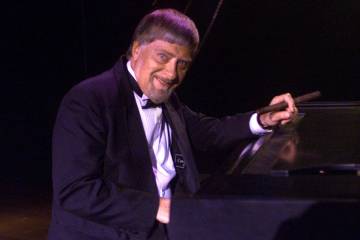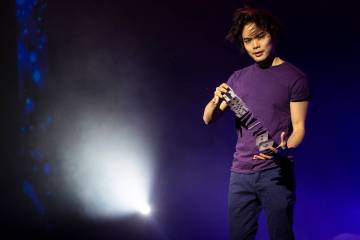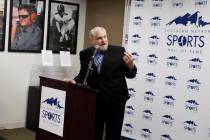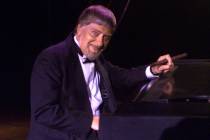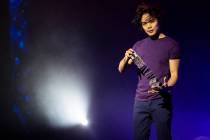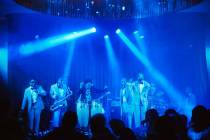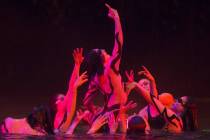Staging carefully crafted to not overpower singing in Celine Dion show
Hey, Phantom, Celine has a chandelier too.
It weighs 700 pounds, is made of Swarovski crystal, and was handmade in Montreal by 10 people wearing white gloves. Plus, it rotates.
But if you don't go home talking about it -- as you do after the Phantom nearly drops one on you -- that's fine with the creators of Celine Dion's show at Caesars Palace.
"That means you didn't lose focus of her performance, of her singing," says the show's production designer, Yves Aucoin.
The show they simply call "Celine" may be the sneakiest spectacle in Las Vegas history.
It's produced to the nines, with a surprising visual every few songs.
But you don't feel like you're watching a fashion show, as with previous Colosseum tenant Cher. And you don't feel like you're playing "Where's Waldo?" to locate the star, as you sometimes did in the early years of Dion's last, dance-heavy opus, "A New Day."
The focus this time is on the musicality of the singer and her orchestra. Even if that orchestra doesn't stay rooted in one place, and some of the singing is with a holographic Andrea Bocelli.
The philosophy for the new production was, "We have a powerful singer there and we never want to distract from that," says Aucoin, a Canadian who has been part of Dion's career since 1989. He likes to have "a wow factor," but "I don't want people talking about (stagecraft) more than her."
When "A New Day" opened in 2003, it had been a long time since "Titanic" and all concerned thought it wise to hedge the giant bet with Cirque du Soleil-style production. "Now we know people are coming to see her," Aucoin says. "Year after year, they are really coming for her.
"This time we were a little more secure about, if we think this will please our crowd, we should do it."
Still, there were expectations. "There was no way we would come back with a cheaper version (of 'A New Day')," says Aucoin, who calls the new approach more "a reorientation."
"Now, at 43 years old, with the material she has to sing, the way she is with the family and what she wants to give to the audience and to the fans, that was the right moment to settle down, with less movement around her and more focus on the music."
That said, the show is full of memorable stagecraft, some of it groundbreaking and difficult to pull off:
■ The opening curtain drop, when a 2,000-pound white scrim (3,000 yards of fabric) running the width of the stage is whisked away to reveal the orchestra.
It's all in the timing. "We had a lot of nights it was scary," Aucoin says, with the machine he labels with a highly technical term: "the sucker." The giant vacuum once had it in for a guitar on a stand, and once it even started to pull in a human (who escaped unharmed).
The secret turned out to be letting the fabric free-fall for two seconds before it is sucked to the wings.
"That's really a Celine idea," Aucoin adds of the show-opening Journey song "Open Arms." When it came time for the big chorus, "now we reveal the orchestra and make the people feel warm about us coming back. That's the way she explained it to me."
In the past, the singer left most creative decisions to her husband-manager Rene Angelil and various collaborators. But this time, even pregnant with twins, "she was really involved in this show, more than any show I've done with her for the last 20 years," Aucoin says.
"Maybe it's where she's at in her age ... she feels confident of what she wants to do now. She's a grown-up!" he says with a laugh.
■ A fakeout in which the audience sees a projected Dion onstage, before the real one pops up in the audience. It's followed by a dimensional duet, last year with Stevie Wonder and currently with Bocelli.
What people call a hologram is really the latest version of a Pepper's Ghost, a stage effect used since the 1860s. The basic principle of glass reflecting a hidden mirror image is "a pretty simple effect -- on paper," Aucoin says.
Here, it had to work from the perspective of all 4,300 seats. "It's quite an easy process if you want to please the center part of the audience. But if you want to please everyone in the room, it's a little bit more complicated."
Apart from the particulars of high-definition video shot against a green screen (Bocelli was filmed in New York, Wonder and Dion in Las Vegas), "it's just reflection and illusion."
Failure was not an option from the day in June 2010 when Angelil saw a small model version of the effect. "He was so blown away by it that I was stuck with it," Aucoin says with a laugh.
■ An orchestra on the move, with a bandstand that moves 15 string players and a five-piece horn section on and off the stage in split pieces.
"Some of those risers are wireless," Aucoin says. Instead of a track, they are guided by a mini-GPS system. "They are all going wherever we want. But it was not like, behaving well when we started, because it was not done before. It took us a long time to make it work properly."
In lieu of dancers this time, the musicians step up to be featured in different configurations during Dion's costume changes. "From the beginning, it was clear to me the costume change should not be a bummer for the audience," Aucoin says.
■ The climactic water feature for "My Heart Will Go On," which hoists the singer to the top of a giant fountain that makes swirling, cylindrical patterns of water.
This turned out to be the most complicated effect, so much that it didn't make it into the first 20 performances.
Aucoin thought the problems would lie in programming the water and keeping the singer dry. Instead, "it was the pool at the bottom, the receptacle for the water. That caused a lot of problems."
Because none of the early reviews mention the fountain, however, "It's a real surprise. Suddenly you have an effect that nobody talked about before."
Alas, now it works so well, "a lot of people don't think that's real water. They think it's another hologram or something."
Contact reporter Mike Weatherford at mweatherford@ reviewjournal.com or 702-383-0288.
Preview
Celine Dion
7:30 p.m. Saturday-Sunday, Tuesday-Wednesday
Colosseum at Caesars Palace, 3570 Las Vegas Blvd. South
$55-$250 (877-423-5463)



